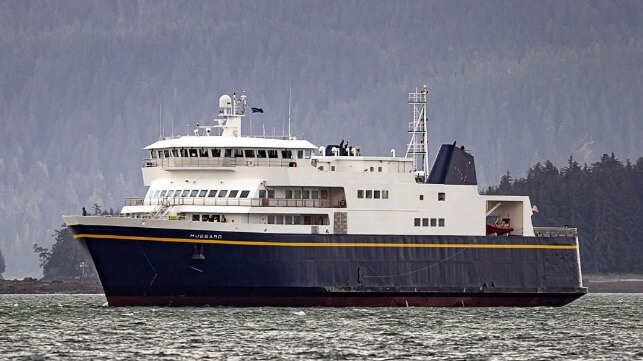Alaska Ferry Sails Maiden Voyage Nearly Five Years After Delivery

The Alaska Marine Highway System celebrated the maiden voyage of its newest ferry nearly five years after the vessel was delivered. It comes as the troubled system looks to turn around its operational problems and renew its fleet with the aid of the federal government.
The Marine Highway System is vital in the state where road systems often do not interconnect cities. The ferries make up a large part of Alaska's highway system, covering 3,500 miles of coastline providing service to over 30 communities that stretch from Bellingham, Washington to Dutch Harbor in the Aleutian Chain. Due to staffing shortages and an aging fleet, portions of the service are suspended and capacity is limited.
The 280-foot ferry named Hubbard (3,000 dwt) was the first of two ferries hailed to help with the modernization of the system when they were ordered nearly a decade ago. The concept of adding two new vessels to enhance service was proposed 17 years ago. It would take four years to build the Hubbard and her sister ship the Tazlina, which became the first ferries built in the state for the system.
Designed to carry 300 passengers and up to approximately 50 cars each of the ferries is operated by a crew of 14. The original concept was to use them for day service around the state capital of Juneau and along the Lynn Canal. A prior governor had proposed along with building the ferries to extend the road system to shorten the trip. As such, the ferries were built without sleeping accommodations for passengers or crew. When the road system was not extended, the ferries usefulness was reduced because of a U.S. Coast Guard rule limiting the ferry crews to 12 hours of work per day and required rest periods.
By the time the ferry was delivered at the end of 2018, the operators had decided that it needed to be redesigned to make up for the lack of accommodations. Finally, in 2021 bidding was opened for the project to add accommodations to the Hubbard.
The Hubbard recently completed a $15 million project adding crew quarters to the vessel at Vigor Shipyard in Ketchikan. The project included the addition of eight single-person staterooms on the Bridge Deck and eight two-person staterooms on the Upper Deck. Additional upgrades included the installation of a galley, scullery, and mess spaces on the Upper Deck, a new fan room on the Bridge Deck, and the extension of the existing port stair tower to the Bridge Deck. Media reports however note the galley is too small to provide hot meals for large passenger loads so the plan is to only operate a cafeteria with sandwiches and soup.
The U.S. Coast Guard finally issued the vessel her Certificate of Inspection and on May 23 she embarked her first passengers. Executives with the marine highway note that the reconstruction expanded the vessel’s operating range and will provide additional flexibility and redundancy in the system. She is operating six days a week between Juneau, Haines, and Skagway.
“Adding crew quarters to the Hubbard gives us flexibility in the AMHS fleet, allowing the ship to sail to more ports when needed,” said Alaska Governor Mike Dunleavy. “Revitalizing the fleet is important to the long-term health of the Marine Highway, and the communities it serve.”
The system currently has nine vessels but only six are in service. The Hubbard’s sister ship was recently taken out of service with a plan to also add accommodations to extend her capabilities. The oldest ship in the fleet, the Matanuska is 60 years old and laid up and likely never to return to service as it requires extensive steel work. Another vessel, the Tustumena, remains in service at age 59 with planning underway for its replacement possibly to enter service in 2027 or 2028.
The largest portion of the U.S. Department of Transportation’s annual grants to ferry systems, a total of nearly $286 million, was awarded this year to the state of Alaska, which will be invested in the Alaska Marine Highway. The award includes $72 million to modernize four Alaska Marine Highway System vessels to ensure reliable service by improving their state of repair. An additional $68 million is dedicated to replacing the Tustumena, and a further $46 million is also provided to build an electric ferry.
Monies are also being provided to Alaska for the system’s port infrastructure and operations. Critics point out that while they have finally placed the Hubbard into service and it provides expanded capacities on an important Southeast route, docks in several communities still need to be upgraded to accommodate the larger Hubbard and her sister ship.
